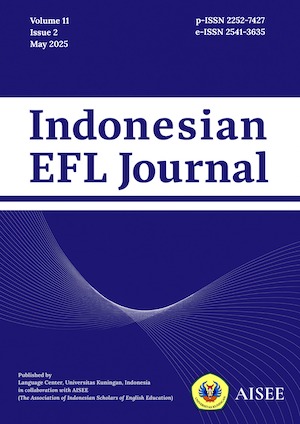STUDENTS’ PERCEPTION OF USING THE AI GRAMMAR CHECKER APPLICATION IN LEARNING ENGLISH FOR HIGH SCHOOL STUDENTS
Abstract
The use of technology in education has become increasingly important in recent decades. One area where technology makes a significant contribution is in English language learning. English is an international language that is important to master in this era of globalization. High school students around the world are trying to improve their English skills in speaking, writing, reading, and listening. This research aims to explore Students’ Perception of using the AI Grammar Checker application in learning English for high school students. An exploratory qualitative research design was used to gain a comprehensive understanding of students' experiences with the AI Grammar Checker and its impact on their English learning. Data collection was carried out through in-depth interviews, questionnaires, and direct observation. The collected data was analyzed using a thematic analysis approach. The results showed that most students found the AI Grammar Checker application useful for improving their English grammar skills. However, some students felt that the recommendations provided by the application were sometimes irrelevant. While the majority reported a positive impact on their writing skills, some did not feel a significant effect. Overall, this research indicates that the AI Grammar Checker application has great potential for improving English learning for high school students. However, it is important to understand individual student needs and make adjustments in the use of the application to provide maximum benefits.References
Al Mahmud, F. (2023). Investigating EFL students' writing skills through artificial intelligence: wordtune application as a tool. Journal of Language Teaching and Research, 14(5), 1395-1404.
Alotaibi, A. H. E. (2023). The impact of AI-powered Grammarly on enhancing grammar proficiency among Saudi EFL students. Remittances Review, 8(4).
Arly, A., Dwi, N., & Andini, R. (2023, November). Implementasi Penggunaan Artificial Intelligence Dalam Proses Pembelajaran Mahasiswa Ilmu Komunikasi di Kelas A. In Prosiding Seminar Nasional Ilmu Ilmu Sosial (SNIIS) (Vol. 2, pp. 362-374).
Baron, N. S. (2023). How ChatGPT robs students of motivation to write and think for themselves. The Conversation.
Barrett, A., & Pack, A. (2023). Not quite eye to AI: student and teacher perspectives on the use of generative artificial intelligence in the writing process. International Journal of Educational Technology in Higher Education, 20(1), 59.
Chan, C. K. Y., & Hu, W. (2023). Students’ voices on generative AI: Perceptions, benefits, and challenges in higher education. International Journal of Educational Technology in Higher Education, 20(1), 43.
Chang, T. S., Li, Y., Huang, H. W., & Whitfield, B. (2021, March). Exploring EFL students' writing performance and their acceptance of AI-based automated writing feedback. In Proceedings of the 2021 2nd International Conference on Education Development and Studies (pp. 31-35).
Chen, X., Liu, Q., & Wang, Y. (2021). Exploring the Use of AI-Powered Virtual Tutors and Chatbots in English Teaching. Journal of Educational Technology, 45(2), 78-94.
Fitria, T. N. (2021, December). Artificial intelligence (AI) in education: Using AI tools for teaching and learning process. In Prosiding Seminar Nasional & Call for Paper STIE AAS (pp. 134-147).
Fitria, T. N. (2021). Grammarly as AI-powered English writing assistant: Students’ alternative for writing English. Metathesis: Journal of English Language, Literature, and Teaching, 5(1), 65-78.
Liu, S., & Kong, Q. (2019). Enhancing Pronunciation Instruction with AI-Based Speech Recognition Systems. TESOL Quarterly, 53(2), 345-368.
Maphoto, K. B., Sevnarayan, K., Mohale, N. E., Suliman, Z., Ntsopi, T. J., & Mokoena, D. (2024). Advancing students' academic excellence in distance education: Exploring the potential of generative AI integration to improve academic writing skills. Open Praxis, 16(2), 142-159.
Mohamed, A. M. (2024). Exploring the potential of an AI-based Chatbot (ChatGPT) in enhancing English as a Foreign Language (EFL) teaching: perceptions of EFL Faculty Members. Education and Information Technologies, 29(3), 3195-3217.
Moybeka, A. M., Syariatin, N., Tatipang, D. P., Mushthoza, D. A., Dewi, N. P. J. L., & Tineh, S. (2023). Artificial Intelligence and English Classroom: The Implications of AI Toward EFL Students’ Motivation. Edumaspul: Jurnal Pendidikan, 7(2), 2444-2454.
Murata, Y. (2023). EVALUATING GENERATIVE ARTIFICIAL INTELLIGENCE AND INTERNET SEARCHES IN FOREIGN LANGUAGE GRAMMAR LEARNING: EXAMINING THE ROLE OF EXPERTS THROUGH A STUDY ON VOCABULARY BEGINNING WITH “MER-” IN MALAY. Journal of Research and Innovation In Open and Distance Learning, 3(1), 55-68.
Ni, A., & Cheung, A. (2023). Understanding secondary students’ continuance intention to adopt AI-powered intelligent tutoring system for English learning. Education and Information Technologies, 28(3), 3191-3216.
Park, J. (2019). An AI-based English Grammar Checker vs. Human Raters in Evaluating EFL Learners' Writing. Multimedia-Assisted Language Learning, 22(1).
Permana, P. T. H., & Putri, N. L. P. N. S. (2020). Artificial Intelligence dalam Pengembangan Media Pembelajaran Bahasa Inggris. JIIP-Jurnal Ilmiah Ilmu Pendidikan, 3(3), 687-692.
Roe, J., Renandya, W. A., & Jacobs, G. M. (2023). A review of AI-powered writing tools and their implications for academic integrity in the language classroom. Journal of English and Applied Linguistics, 2(1), 3.
Schmidt-Fajlik, R. (2023). ChatGPT as a Grammar Checker for Japanese English Language Learners: A Comparison with Grammarly and ProWritingAid. AsiaCALL Online Journal, 14(1), 105-119.
Subiyantoro, H., Hartono, R., Fitriati, S. W., & Faridi, A. (2023, June). Dampak kecerdasan buatan (AI) terhadap pengajaran Bahasa Inggris di perguruan tinggi: Tantangan dan peluang. In Prosiding Seminar Nasional Pascasarjana (Vol. 6, No. 1, pp. 346-349).
Sugiyono. (2019). Metode Penelitian Kuantitatif, Kualitatif, dan R&D. Bandung : Alphabet.
Sugiyono. (2020) Metode Penelitian Kualitatif. Bandung: Alfabeta.
Wang, X., Liu, Q., Pang, H., Tan, S. C., Lei, J., Wallace, M. P., & Li, L. (2023). What matters in AI-supported learning: A study of human-AI interactions in language learning using cluster analysis and epistemic network analysis. Computers & Education, 194, 104703.
Zhang, Y., & Zhang, H. (2022). Adaptive Learning Systems in English Teaching: A Review of AI-Based Approaches. Language Teaching Research, 26(1), 34-52.









